"...American history is longer, larger, more various, more beautiful and more terrible than anything anyone has ever said about it..." -James Baldwin
121 posts
Latest Posts by religionamericanhistory - Page 2
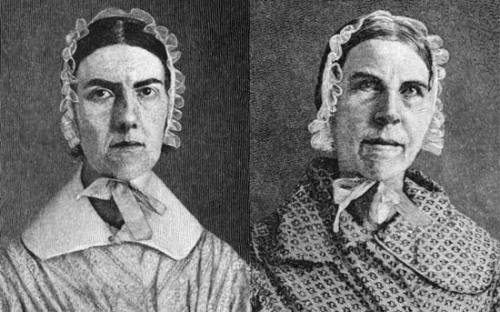
Sarah Grimké and Angelina Grimké Weld were feminists, Quakers, and the first widely known American female abolitionists. The Grimké sisters grew up on a plantation in South Carolina, where they witnessed the cruelties of slavery firsthand. Despite stark disapproval from their family, they eventually became Quakers and began writing and speaking on behalf of the abolitionist movement. Their talks began as “parlor meetings,” where they spoke in front of small gatherings of women, but they soon began to attract larger and larger audiences of both men and women. Many Southerners and Northerners criticized the Grimke sisters for their public speaking campaigns, because they felt women had no business being orators. They faced rampant criticism and became virtual social outcasts in the South, but the Grimké sisters continued to fight for their feminist and abolitionist ideals.

On May 6, 1882 President Chester A. Arthur signed into law the Chinese Exclusion Act, prohibiting all immigration of Chinese laborers to the U.S. This was the first law in the United States to target a specific ethnic group for exclusion from immigration and was not repealed until 1943, when China became an ally of the United States against Japan and the Magnuson Act set a yearly national quota of 105 (!) Chinese immigrants. Despite this, and the other often hostile legal and social impediments faced by Chinese Americans, communities persevered. The image above is of a Chinese grocery in San Francisco around 1904, just before the great Quake of 1906. From: The United States of America: one hundred albertype illustrations from recent negatives of the most noted scenes of our country by Adolph Wittemann (1904).
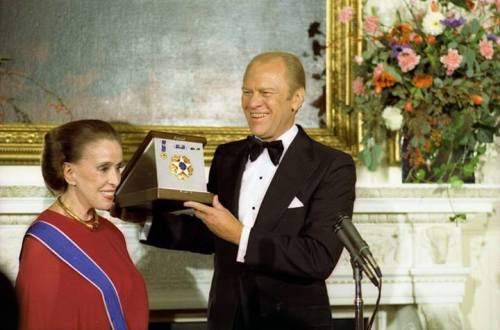
Born on this day, May 11, 1894, Martha Graham
President Ford presented Martha Graham with the Presidential Medal of Freedom, the nation’s highest civilian honor, on October 14, 1976. Martha Graham began choreographing and performing her own works in the late 1920s and early 1930s. In 1935 she helped establish the School of Modern Dance at Bennington College, where a young Betty Bloomer Ford would study a few years later. The Martha Graham Dance Company, the oldest major dance company in the United States, began touring internationally in 1950. At the presentation President Ford read the award citation: “Dancer, teacher, choreographer, Martha Graham has captivated the world with her magic and has left a legacy of imagination with all who have witnessed her talent. Her energy, creativity and daring have opened new doors of expression in dance. Her followers and friends adore her, and her country, the United States of America, is proud to proclaim her a brilliant star and a national treasure.” Following the presentation Janet Eilber, principal dancer with the Martha Graham Dance Company, performed the solos “Lamentation” and “Frontier.” Graham had choreographed both dances.
-from the Ford Library
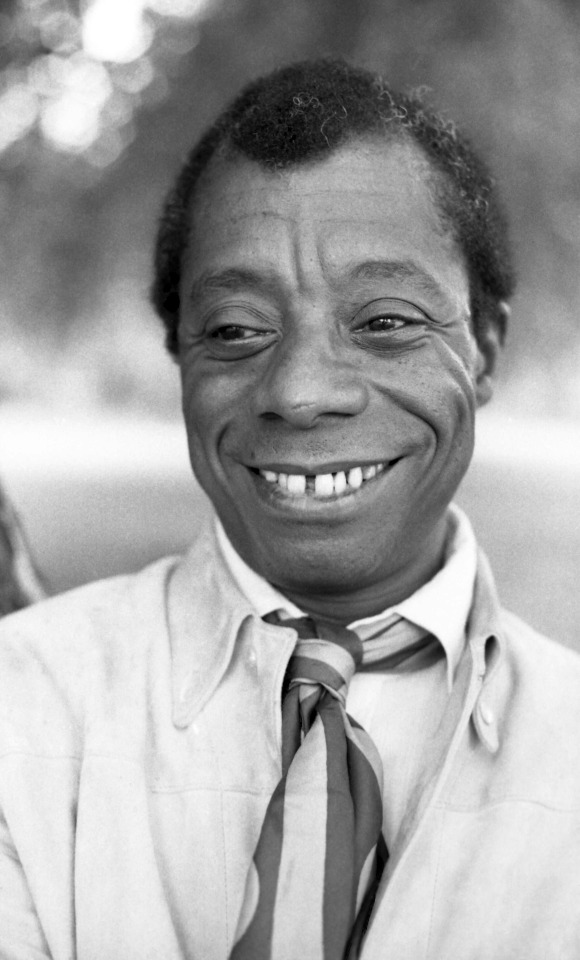
Next week at Harlem Stage: Schomburg Director Khalil Gibran Muhammad and Dr. Fredrick Harris, Professor of Political Science and Director of the Center on African-American Politics and Society at Columbia University, engage in a critical dialogue building from Baldwin’s view of history and his critique of America.
RSVP by clicking the image above.
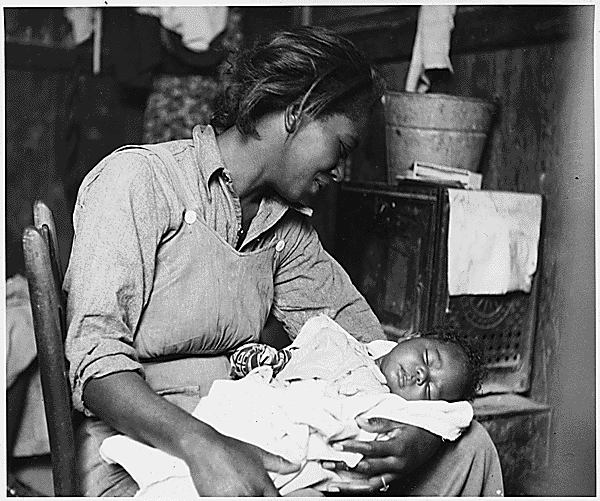
Happy Mother’s Day!
Holidays honoring motherhood are observed in different forms throughout the world. The roots of the modern American Mother’s Day date back to the 19th century. In the years before the Civil War (1861-65), Ann Reeves Jarvis of West Virginia helped start “Mothers’ Day Work Clubs” to teach local women how to properly care for their children. Later, Jarvis organized “Mothers’ Friendship Day,” at which mothers gathered with former Union and Confederate soldiers to promote reconciliation.
It was her own daughter, Anna Jarvis, that petitioned for recognition of the holiday. It became an official U.S. holiday in 1914, with a presidential proclamation from President Woodrow Wilson.
Image: “Near Buckeye, Maricopa County, Arizona. Migrant [African-American] cotton picker and her baby., 11/1940″ by Dorothea Lange
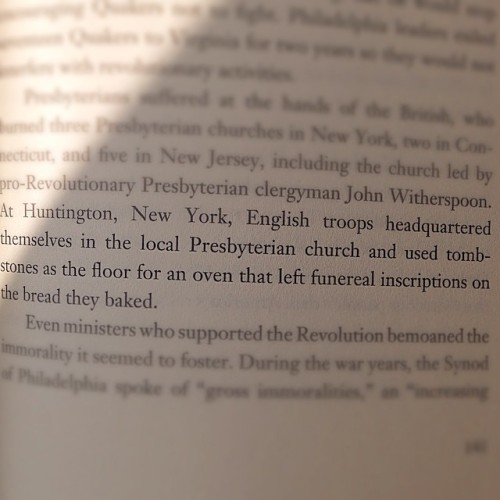
Filed in: "Culinary History of American Revolutionary Religion"
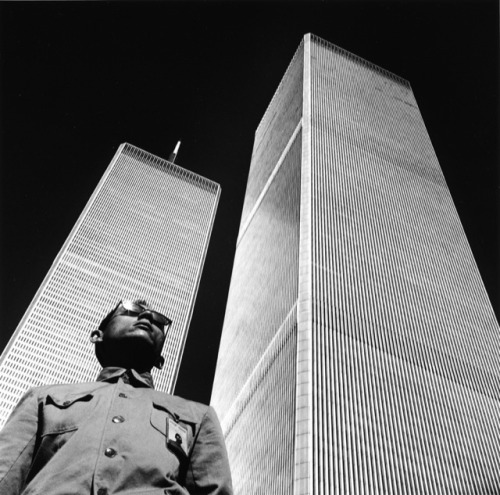
As an Asian boy growing up middle-class in America, I was taught assimilation was key. With the right dress and verbal codes, I could be a part of the the healthy, wealthy, and white lifestyle of magazines and sitcoms. Of course, I learned later this was false, and encountering the work of Tseng Kwong Chi helped me bury those aspirations for good. In his best-known series, East Meets West, Tseng photographed himself as the ultimate outsider: wearing reflective sunglasses and a “Mao” jacket, chin tilted up and unsmiling as he posed by the great monuments of the West — Disneyland, Notre Dame, the World Trade Center.
How a Queer Asian Artist Infiltrated the New York Scene Through Dress-Up and Self-Portraiture
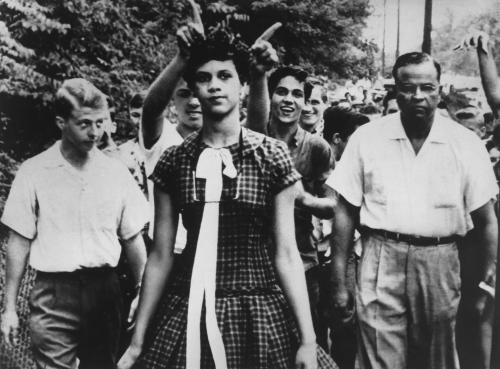
A crowd of youths taunt Dorothy Counts, 15, as she walks to the previously all-white Harding High School to enroll, September 4, 1957, Charlotte, NC. Leaving the school, she was pelted with trash, small sticks and pebbles -
via reddit
Keep reading
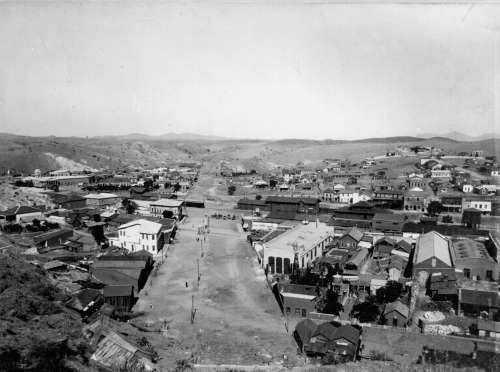
Border between the United States and Mexico. Town of Nogales, Arizona is on the left and Nogales, Sonora, Mexico on the right. Sometime around 1898-1899.
via reddit
It was after the bars had closed and well into the pre-dawn hours of an August morning in 1966 when San Francisco cops were in Gene Compton’s cafeteria again. They were arresting drag queens, trans women and gay hustlers who had been sitting for hours, eating and gossiping and coming down from their highs with the help of 60-cent cups of coffee.
The 24-hour eatery was a local favorite. It was centrally located — adjacent to the hair salon, the corner bar and the bathhouse — and provided a well-lit and comfortable haven for trans women performing in clubs or walking the streets in San Francisco’s Tenderloin neighborhood.
From Compton’s “you could walk to Woolworth’s to buy [fake] eyelashes, and it was two blocks from the airline bus terminal,” where Tamara Ching says many drag queens and trans women would go to change from male to female clothes. Ching is an Asian-American transgender woman who grew up in San Francisco. She frequented the Tenderloin during the 1960s and has lived there since 1992. “Everybody that lived in the Tenderloin ate at Compton’s,” Amanda St. Jaymes, a transgender woman who ran a residential hotel nearby, said in a documentary, Screaming Queens, which chronicles a confrontation with police that marked the start of a movement toward LGBT rights.
Compton’s management didn’t want the cafeteria to be a popular late-night hangout for drag queens, trans women and hustlers. Workers would often call the police at night to clear the place out. The Tenderloin, where sex work, gambling, and drug use were commonplace, was one of only a few neighborhoods where trans women and drag queens could live openly. Yet they were still regularly subject to police harassment and arrested for the crime of “female impersonation.”
And when a policeman in Compton’s grabbed a drag queen, she threw a cup of coffee in his face. The cafeteria “erupted,” according to Susan Stryker, a historian who directed Screaming Queens. People flipped tables and threw cutlery. Sugar shakers crashed through the restaurant’s windows and doors. Drag queens swung their heavy purses at officers. Outside on the street, dozens of people fought back as police forced them into paddy wagons. The crowd trashed a cop car and set a newsstand on fire.
“We just got tired of it,” St. Jaymes told Stryker. “We got tired of being harassed. We got tired of being made to go into the men’s room when we were dressed like women. We wanted our rights.”
Ladies In The Streets: Before Stonewall, Transgender Uprising Changed Lives

Gay men smash the windows of San Francisco City Hall in 1979, with thousands rioting after Dan White received a verdict of voluntary manslaughter for the killing of Harvey Milk.
via reddit
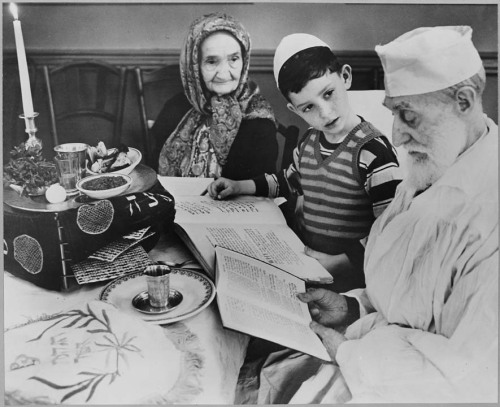
May is Jewish American Heritage Month, a time to celebrate the contributions of Jewish people to American culture throughout the centuries.
One of the first recorded Jewish immigrants to the future United States was Elias Legarde, a Frenchman who travelled to the colonies in 1621 to teach the early settlers about wine cultivation. Most colonial-era Jewish immigrants settled in the areas around New Amsterdam (New York); Maryland; Pennsylvania; and Savannah, Georgia, which is home to one of the oldest Jewish communities in the South.
Jewish people fought on both sides during the Revolutionary War, though the majority sided with the colonies. President George Washington remembered their contributions when he wrote to a Jewish congregation in Rhode Island, in a letter dated August 17, 1790: “May the children of the stock of Abraham who dwell in the land continue to merit and enjoy the goodwill of the other inhabitants. While everyone shall sit safely under his own vine and fig-tree and there shall be none to make him afraid.”
Image: “Photograph of a Young Jewish Boy with Elders at a Passover Ceremony, 4/16/1951”
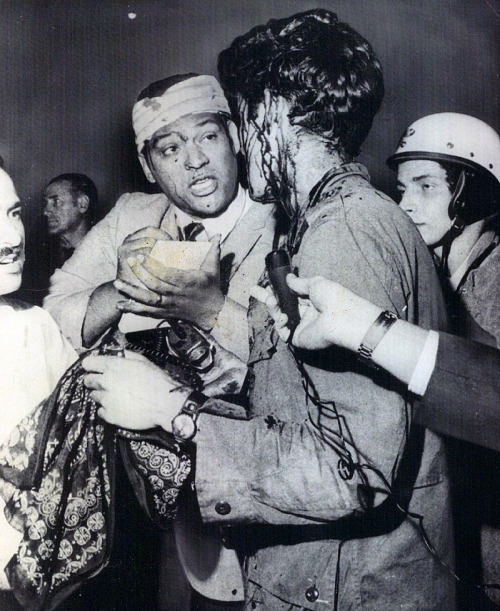
A bleeding journalist interviews a bleeding activist after one of the most violent attacks on protesters by police during the 1968 Democratic National Convention in Chicago. “The whole world is watching” is a reference to this event
via reddit
Keep reading
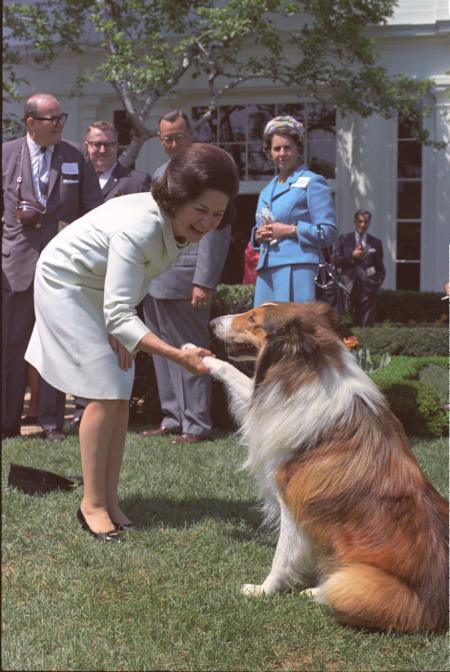
A VIP (Very Important Pup) at the White House
Lady Bird greets Lassie at the White House May 3, 1967.
-from the LBJ Library #C5290-28
Watch this documentary on the transgender women who fought back against police harassment at Compton’s Cafeteria in 1966, San Francisco, three years before Stonewall.
The Gay 80s.

“You don’t have to be a man to fight for freedom. All you have to do is to be an intelligent human being,” Dr. Betty Shabazz.
The civil rights activist, nurse and educator, emphasizes the efforts of women leaders. On May 3rd, Women in Islam will honor women who have echoed the work ethic of Dr. Betty Shabazz in the common goal for justice.
For more information and to purchase tickets, click on the photo, visit womeninislam.org or call (212) 576-8875.
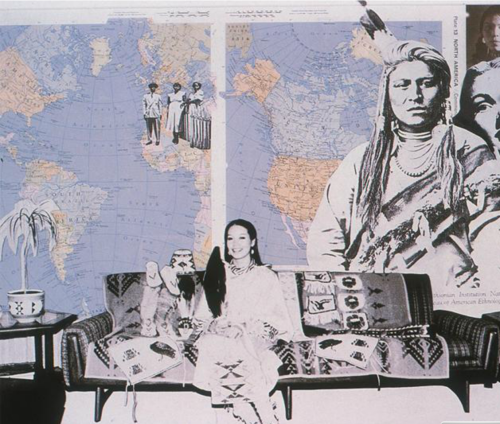
Hulleah Tsinhnahjinnie, When Did Dreams of White Buffalo Turn to Dreams of White Women, 1990
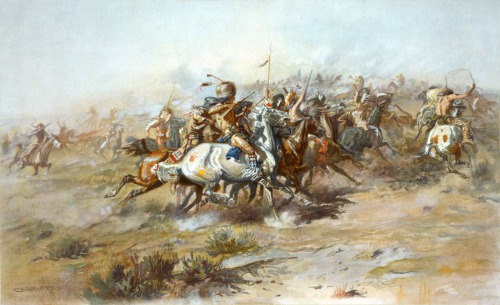
After years of oppression by the U.S. government, thousands of Native Americans rallied under Sitting Bull and Crazy Horse in the Battle of the Little Bighorn. Over 10,000 Native Americans gathered in an area alongside the Little Bighorn River, despite the U.S. War Department’s threat to attack if they did not return to their reservations. U.S. Cavalry Commander George Custer attempted to attack, but his troops were quickly overwhelmed by the Native Americans. Within an hour, Custer and all of his soldiers were dead, and the battle became known as Custer’s Last Stand. The Battle of the Little Bighorn was a decisive Native American victory, and represented years of outrage against the U.S. for stealing their homelands and depriving them of basic rights.
Image: The Custer Fight by Charles Marion Russell
The Complicated Racial History of Missouri

Photo: A photograph of Dred Scott, taken around the time of his court case in 1857.
This Saturday, the Smithsonian’s National Museum of African American History and Culture (NMAAHC) will present a public symposium dedicated, in part, to examining police violence against black people in Ferguson, and across the country.
These tragic events baffled some Americans. For others, they evidenced what many of us have known all along: that our nation has struggled with race and racial violence since its inception. Missouri is no exception.
Throughout its history, Missouri has been a bellwether for racial tensions, violence, and legislation in America. In 1819, Missouri (then, a U.S. territory) applied to be admitted to the Union as a slave state. At the time, there was a delicate balance of political power between slave states and free states, and Missouri’s admission threatened to tip the scales in favor of slavery and cause serious sectional conflict. To avoid this, Congress passed the Missouri Compromise in 1820, a bill that allowed Missouri to be admitted as a slave state and Maine as a free state, but prohibited slavery (with the exception of Missouri) north of the latitude 36°30′. By 1857, this law would be completely dismantled by the Supreme Court in the landmark Dred Scott v. Sanford case.
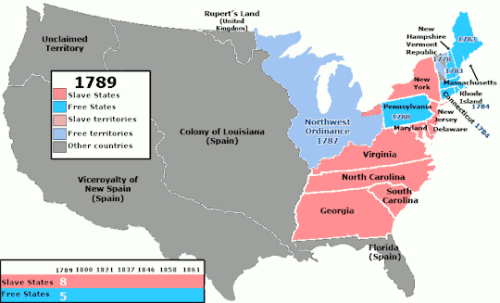
Photo: Animation showing which areas of the United States did and did not allow slavery between 1789 and Lincoln’s inauguration in 1861. Wikimedia Commons, Kenmayer.
Dred Scott was an enslaved man who, like many other African Americans in Missouri, sued for his freedom. He argued that by being relocated north to areas where slavery was not permitted, he could make a legal claim for his freedom. Instead, the Supreme Court ruled in 1857 that both free and enslaved African Americans were not citizens and therefore could not bring suit in a federal court. Moreover, the Missouri Compromise was found to be unconstitutional because the court believed Congress had no authority to prohibit slavery in U.S. territories, or deny slaveholders of their human property.
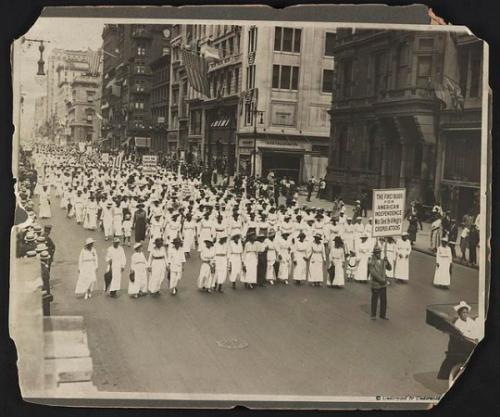
Photo: Silent protest parade in New York [City] against the East St. Louis riots, 1917. Prints and Photographs Division, Library of Congress.
Even after the Civil War came to a close in 1865 and the 14th amendment was ratified in 1868, African Americans in Missouri still faced a climate of racial terror. Sundown towns – communities where the presence of African Americans after dark was restricted by threat of violence or death– were common throughout the state between 1890 and 1910. Such violence against African Americans was rarely seen as illegal, let alone met with real consequences. So it should come as no surprise that by 1917, the East St. Louis race riots in Illinois (just miles from Ferguson), were one of the most violent in our nation’s history. African American migrants from the south were replacing white workers in the city, and soon tensions boiled over. White mobs attacked black men, women and children in public. African Americans were beaten to death, shot dead in the streets, and their homes were set ablaze with inadequate police response. But vigilante violence was not the only element that made black life precarious. Until 1948, African Americans in Missouri were kept out of white neighborhoods by restrictive covenants. When these covenants were outlawed by the Supreme Court, zoning was strategically used to ensure that St. Louis would remain one of the country’s most segregated cities well into the 21st century. These factors have undoubtedly contributed to the state’s current crisis of poverty, racial inequality and civil unrest.
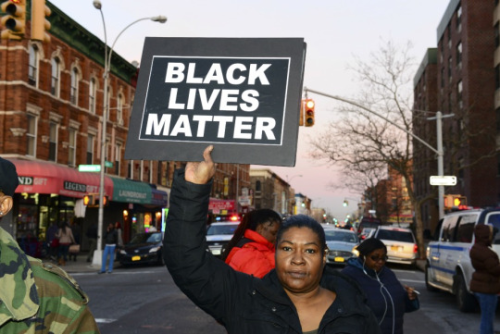
Photo: Protesters in the Black Lives Matter movement.
The recent events in Ferguson prompted many Americans to publicly question whether #blacklivesmatter. When residents of Ferguson were put under midnight curfew, questions surfaced as to whether these restrictions werejustified. When protesters flooded a militarized Ferguson, people around the country wondered if the response of the authorities would be measured. And when a grand jury cleared the police officer involved, Americans asked whether justice for African Americans could truly be achieved in the courts.
These questions are not new for Missouri, or our country. As history shows, Americans have wrestled with them for over two centuries. As someone who is interested in history as it informs the present, I was inspired to see how marginalized African Americans in Ferguson built upon a long American tradition of expressing grievances through public protest. They questioned, they demanded, and ultimately helped to inform a dynamic public dialogue. I invite you to continue in the conversation this weekend at “History, Rebellion and Reconciliation: Communities Mobilized for Social Change”.
Tsione Wolde-Michael is the Writer/Editor for the Office of Curatorial Affairs, Smithsonian National Museum of African American History and Culture. She is also a Doctoral Candidate in History at Harvard University.
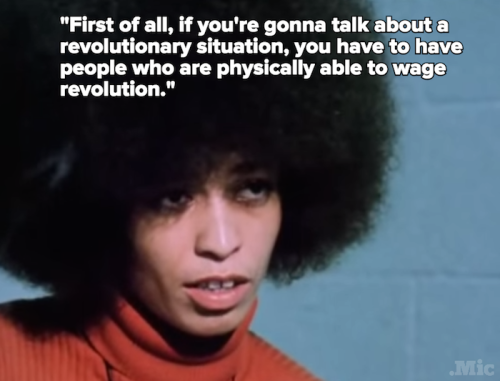
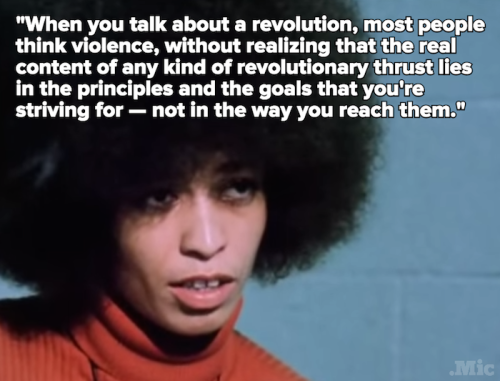
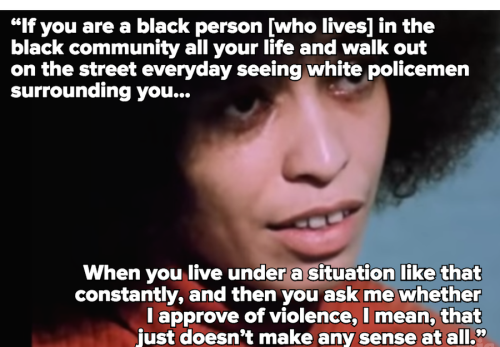
Angela Davis nailed the Baltimore riots perfectly … in 1972
Angela Davis, philosopher-activist and professor, was hunted down by the FBI for a crime she didn’t commit, jailed in 1970, and freed in 1972. While serving her sentence in a California jail, she gave a thoughtful interview (later included in The Black Power Mixtape) about the state of the Black Panthers at that time, and why violence is part of protest, because it is an inherent element in the daily lives of black and brown people. Watch the remarkably relevant video.
The Children’s Crusade, 1963
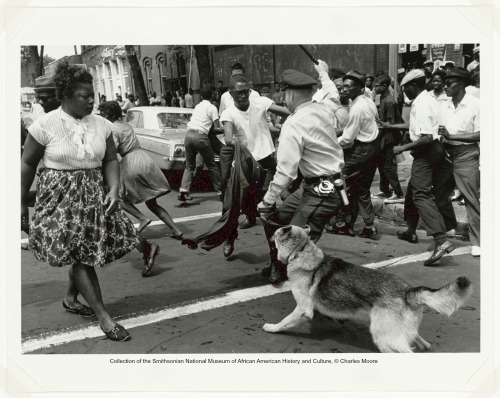
On this day in history, more than a thousand African American students skipped their classes and gathered at Sixth Street Baptist Church to march to downtown Birmingham. As they approached police lines, hundreds were arrested and carried off to jail in paddy wagons and school buses. When hundreds more young people gathered the following day for another march, commissioner Bull Connor directed the local police and fire departments to use force to halt the demonstration. Images of children being blasted by high-pressure fire hoses, clubbed by police officers, and attacked by police dogs appeared on television and in newspapers and triggered outrage throughout the world.
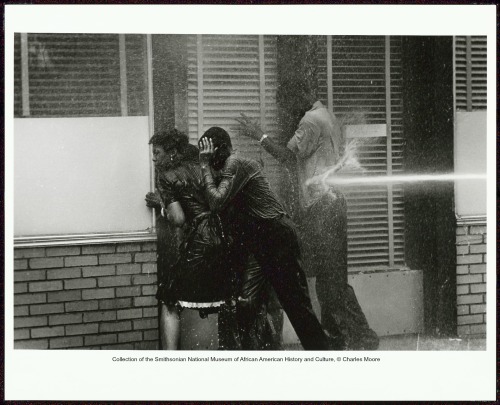
The crusade ended after intervention from the U.S. Department of Justice. The event led to President John F. Kennedy’s full support of racial equality with the eventual passage of the Civil Rights Act of 1964.

NPR covers James Baldwin
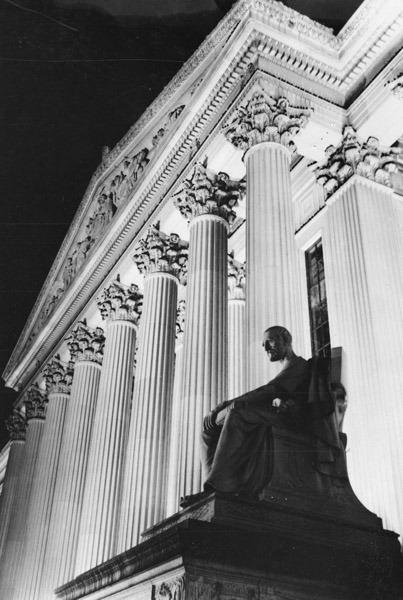
In honor of #NationalPoetryMonth, here are some haiku from our staff about what it’s like working at the National Archives.
Why save old records? It’s our job to protect. And- What’s Past is Prologue. -Mary
Excited tourists See important documents Sends chills up my spine -Dina
Records enlighten. Presidential Libraries connect Then to Now. -Jennifer
Why don’t we trash it? We’re the National Archives Keep, preserve, repair -Joetta
SAMMA’s robot arm Feeds videos to decks and Saves them from decay -Audrey
US History Veterans and ancestry Visit the Archives -Beatriz
Across the country, records are accessible. History lives on.
Records document actions of the government. We preserve them. -Christopher
Let us innovate Scan, research, transcribe, edit Hub opens July -Dina
Across the country Takes all kinds of staffers to Make access happen
With calls, emails, and even letters from prisons, we connect with folks -Cody
National Treasure? No Nick Cage shenanigans… History up close -Brittany
accumulation as we speak of permanence for our future use -Casey
A nerd’s paradise Archives records reveal gems To those who seek them -Grace
Revel in our shared past At the National Archives In person, on web -Lucy
Room, bay, row, unit, shelf Federal Record Center Document, folder, box -Robert
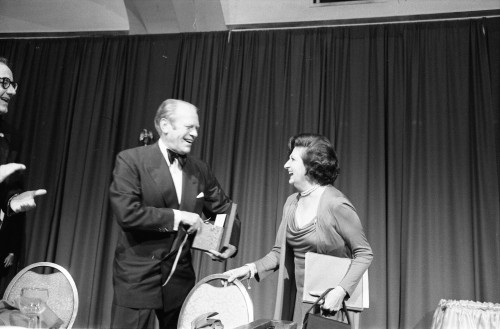
UPI White House correspondent Helen Thomas
Here she and President Ford share a laugh at the 61st Annual White House Correspondents Association Dinner at the Washington Hilton Hotel on May 3, 1975. That evening Thomas was installed as the Association’s first female president. “Helen Thomas has a well-earned reputation for speaking her own mind,” President Ford noted in his remarks at the dinner, one that came from over a decade of covering the presidency. She started as UPI’s White House correspondent during the Kennedy administration in 1961, becoming chief of its White House bureau in 1974. Thomas continued to cover the White House for UPI and other media outlets through the first years of the Obama administration. In addition to asking questions at regular White House briefings and press conferences Thomas interviewed President Ford on several occasions throughout his administration. She also became the first woman admitted to the Washington press corps’ Gridiron Club in 1975.
-from the Ford Library
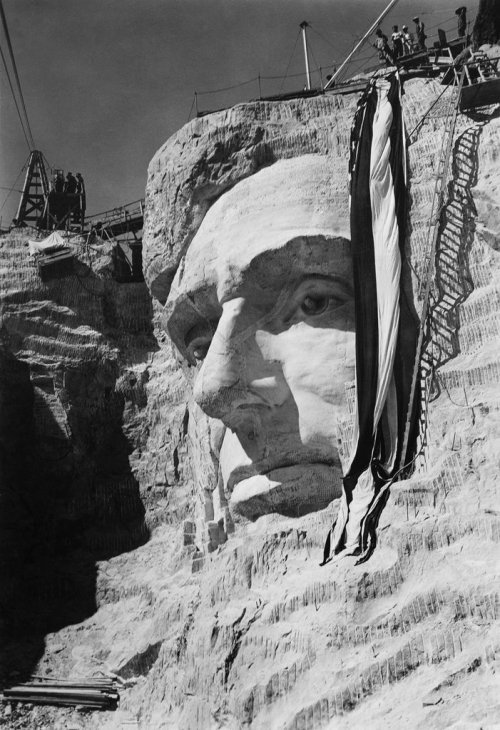
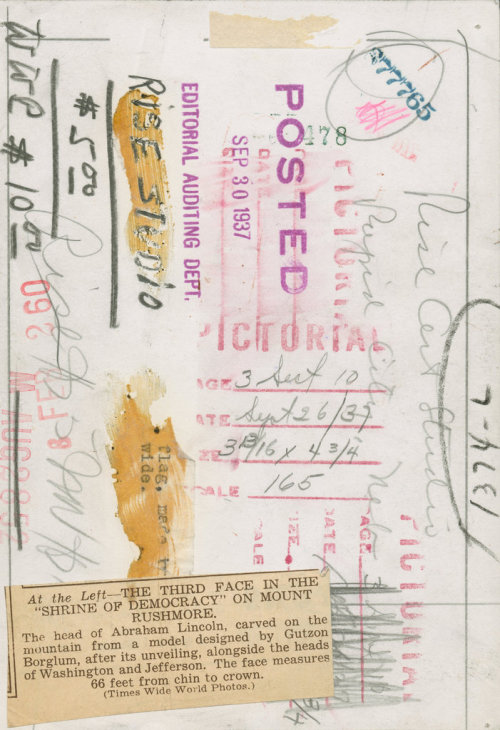
Sept. 26, 1937: Some 5,000 patriots came out to Mount Rushmore in September 1937 to see the unveiling of Abraham Lincoln’s face, measuring “66 feet from chin to crown,” the same height as his fellow granite presidents Washington and Jefferson (Theodore Roosevelt’s head would be dedicated in 1939). Coincidentally, when the “Shrine of Democracy” was presented, on the 150th anniversary of the Constitution’s signing, The New York Times’s lead story concerned another President Roosevelt’s not-quite-so-constitutional court-packing scheme. Photo: The New York Times
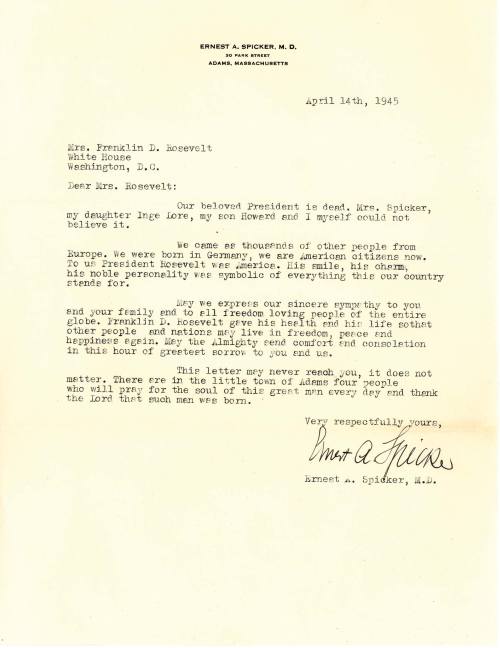

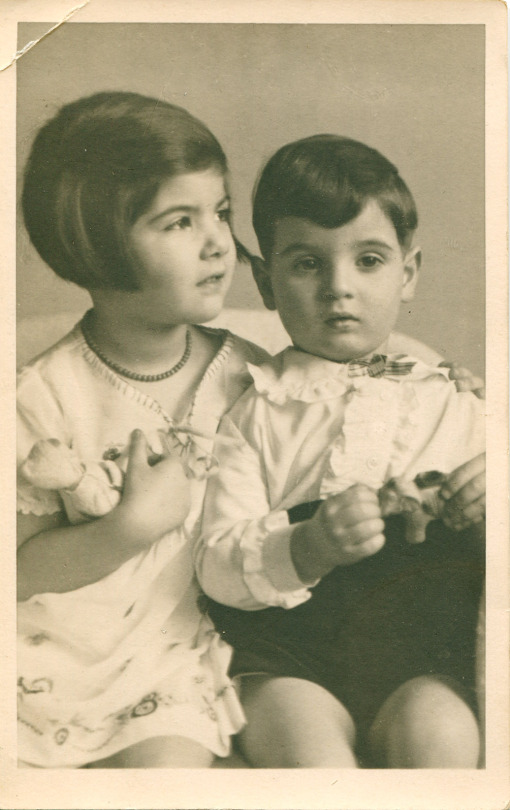
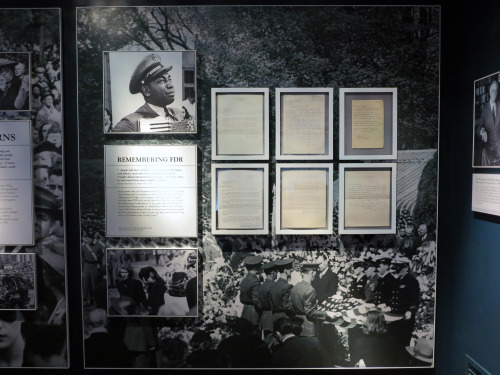
Remembering FDR
One of the best things that can happen at the Roosevelt Library is when a member of the public makes a personal connection with one of the artifacts or documents on display in our Museum. Such an encounter occurred just this week— and, by chance, it relates directly to the 70th anniversary of President Roosevelt’s death, which the nation will remember on April 12.
Nearly 70 years after Dr. Spicker mailed this letter to Mrs. Roosevelt, some current residents of Adams, Massachusetts visited the Roosevelt Library. During their tour of our Museum they read Dr. Spicker’s letter and noticed the Adams address. When they got home, they alerted a town historian in Adams who publishes a newsletter for the Adams Historical Society. He set out to find descendants of the doctor and was able to locate Spicker’s granddaughter, Marianne Spicker, in West Lafayette, Indiana. Marianne guided him to her aunt, Inge Wegener (Dr. Spicker’s daughter), who lives in Lombard, Illinois.
Inge Wegener had no idea that her father had ever written a letter to the First Lady and was moved to tears when she learned his letter was on display at the Roosevelt Library. On April 8, Marianne Spicker phoned the Library to see if she could confirm the story and get a digital copy of her grandfather’s letter. Museum staff quickly provided her with a high resolution scan of the letter and she gave us background information about her grandfather’s story, including this photograph of Dr. Spicker.
You can read more about this story on our blog at: http://fdr.blogs.archives.gov/2015/04/12/remembering-fdr/
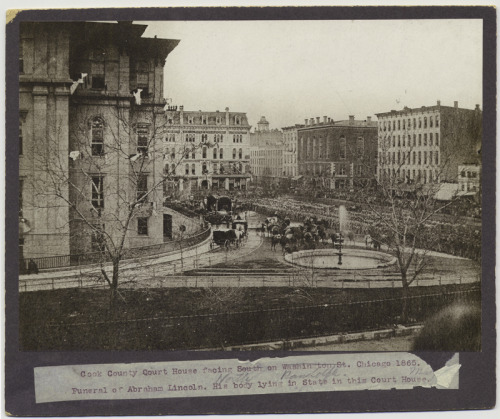
Abraham Lincoln’s funeral procession arrives at the Court House, May 1, 1865
This evening, visit the Chicago History Museum to pay tribute to the sesquicentennial of Abraham Lincoln’s funeral in Chicago. The free program begins at 7:00 p.m.
Purchase a copy E-mail rightsrepro@chicagohistory.org and give them this number: ICHi-52359
Connect with us Visit the Museum’s website Search our digital collection Shop our PhotoStore
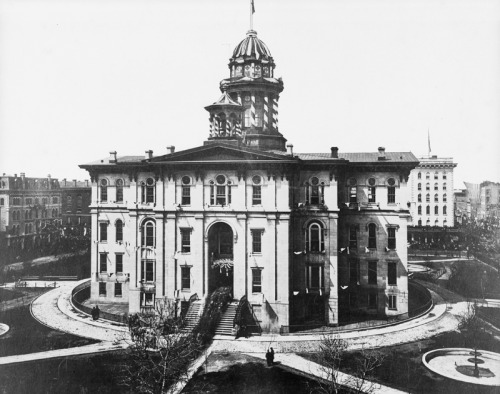
Abraham Lincoln’s funeral procession enters the Court House, May 1, 1865. Photograph by Samuel Montague Fassett.
The body of the fallen president was on view in Chicago for twenty-four hours. More than 125,000 mourners came to pay their last respects.
Purchase a copy E-mail rightsrepro@chicagohistory.org and give them this number: ICHi-11258
Connect with us Visit the Museum’s website Search our digital collection Shop our PhotoStore
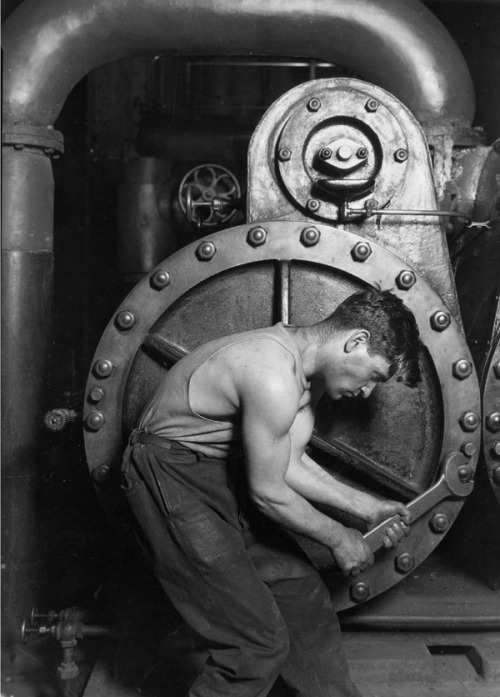
Happy International Workers Day!
Today in 1886, about 200,000 American workers engineered a nationwide strike for an eight-hour work day. A few days later, at a labor rally in Haymarket Square, Chicago, a bomb exploded, killing 11 people, including 7 police officers. Four anarchists were hanged, on flimsy evidence, and the general strike dissipated.
A few years later, in Europe, a newly-formed collection of socialist and labor parties called for a demonstration on May 1 to honor the “Haymarket martyrs” and sustain the struggle for an eight-hour work day. Over the years, the cause evolved into a broader celebration of labor unions and labor rights, which spread around the world.
However, stateside, the holiday didn’t take off; President Grover Cleveland was concerned about the political threat of anarchists and socialists, and so decided on another day to celebrate the more moderate elements of the union movement, and proclaimed the first Monday in September as Labor Day in 1894.
Image: “Power house mechanic working on steam pump” by Lewis Hine, 1920